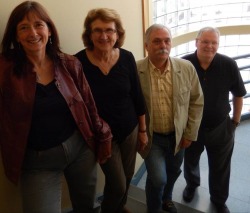Collaborative research gives voice to the Deaf community

Dr. Sandy LeFort has spent over 25 years studying how people experience pain, and how to better assess and manage it. She's really been a pioneering voice in the field.
A faculty member and researcher at Memorial University's School of Nursing since 1995, she's presented at world-wide conferences on the subject, written articles, papers, even developed a patient education program. Her expertise is well-known.
But just a few months ago, Dr. LeFort was asked to collaborate on an area of pain research that was for her, completely new.
How do you assess pain in people who are Deaf, and use sign language to communicate? Surprisingly, there is very little research available that answers this question.
"This is a whole new world we haven't really explored," said Dr. LeFort, who was invited to research the subject by Dr. Victor Maddalena of the Faculty of Medicine's Division of Community Health, and Myles Murphy, executive director of the Newfoundland and Labrador Association for the Deaf (NLAD). The two had been studying palliative care in the Deaf community, and pain assessment was identified as a key issue.
"Nurses are asking people about pain all the time," said Dr. LeFort, "But we'll have a hard time assessing pain and providing treatment if there is a communication barrier."
A literature review confirmed the lack of research; only one article about a research project that Italian nurses did on pain assessment in the Deaf was discovered.
Working with Mr. Murphy, who has been a voice and an advocate for the Deaf community for many years, Drs LeFort and Maddalena set up focus groups among the NLAC membership.
"Hearing people rely on voice, intonation, the doctor can hear the anger and frustration," said Mr. Murphy, speaking through American Sign Language (ASL) interpreter Sheila Keats. "Always the hardest question to respond to is, 'How bad is your pain? Describe your pain?' A Deaf person can't hear so they have to use their eye; the visual cues are the ones you are trying to pick up."
The team made several key findings. They confirmed the importance of both ASL and Deaf interpreters at health care visits, that pain visual analogue scales with 1-10 rankings can be useful but must be easy to read and understand, and that facial expressions depicted in photos or drawings also had potential as a pain assessment tool.
It's the beginning of an important area of research, said Dr. LeFort, and a wonderful partnership with the Deaf community.
The research team plans a second phase of the project to delve further into their findings, and develop tools that will be useful for the Deaf community and for health care practitioners.